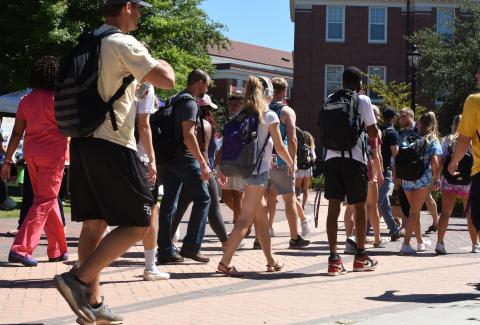Exploring the Trends in Enrollment Rate Demographics
Mar 10,2023
According to the National Center for Education Statistics, there are more than 19 million Americans enrolled at colleges and universities throughout the U.S. right now.
This includes almost 12 million full-time students and about 7.5 million part-time students. It also includes over 16 million students taking part in undergraduate programs and just over 3 million students participating in graduate programs.
If you take a deeper dive into some of the current enrollment rates, you'll find other trends that will begin to emerge. Whether you're a soon-to-be college student interested in enrollment statistics or someone who works in college admissions interested in college diversity, it would be worth exploring these trends further.
Today, we're going to take a closer look at the trends that exist within the enrollment rate demographics at colleges and universities. Check them out below.
More Women Attend College Than Men
A few years ago, reports started to reveal that women were on the verge of making up the majority of the college-educated U.S. labor force. This may have come as a surprise to some people. But it shouldn't have, seeing as how more women have attended college than men for quite a few years in a row now.
This trend continues today as almost 60% of all college students are female. There have been many theories that have been shared over the years about why female enrollment rates at U.S. colleges and universities remain as high as they do.
But one thing is for sure: it doesn't appear as though this trend is going to swing back in the other direction anytime soon. Women are going to outnumber men at colleges and universities for the foreseeable future.
Fewer Men and Women Attend College These Days
You could make the argument that a college education has never been more accessible than it is today. There are so many colleges and universities scattered throughout the country right now. There are also lots of scholarships, grants, etc. that people can use to pay for them.
But despite this, college enrollment rates suggest that many people are second-guessing the decision to go to college. Over the last decade, both men and women have started attending college at lower rates than they used to.
There are roughly 4 million fewer people attending college now than there were just ten years ago. Experts have blamed everything from the country's strong labor market to the COVID-19 pandemic for this. It's an alarming trend, to say the least.
And this is impacting both genders in this country. Male and female enrollment rates have both dipped by about 5% since 2009.
Male and Female Enrollment Rates Are Expected to Rise Soon
At first glance, it might seem as though many Americans have fallen out of love with the idea of going to college to get a better education. But in reality, many education experts are anticipating an increase in male and female enrollment rates at colleges and universities between now and 2030.
According to the NCES, male enrollment is projected to increase by about 11%. It would increase the number of male college students to almost 7.5 million.
Female enrollment is also projected to increase by about 6%. It would result in there being almost 10 million female college students in this country.
Hispanic Enrollment Rates Have Increased Dramatically
The Hispanic population in the U.S. has grown by leaps and bounds over the last two decades. There are well over 62 million Hispanic people in the U.S. today, which is up about 13% from the year 2000.
In large part because of this, Hispanic enrollment rates at U.S. colleges and universities have also soared in recent years. They've increased by about 42% and brought the total number of Hispanic students from just under 2.5 million to nearly 3.5 million.
The Hispanic population now makes up almost 20% of the total U.S. population. So this increase might single-handedly be responsible for increasing college enrollment rates across the board in the years to come. It's one of the reasons why many experts believe there will be more Americans enrolling in colleges and universities than ever before soon.
Enrollment Rates for Other Races and Ethnicities Have Fallen
Hispanic enrollment rates at U.S. colleges and universities have risen a whole lot over the last decade. But enrollment rates for many other races and ethnicities have dropped.
There has been a push for more college diversity across the country. But in spite of this, there has been a decline in enrollment rates for most races and ethnicities.
White enrollment rates have dropped by about 25% since 2009. Black enrollment rates, meanwhile, have dropped by about 21%. But it's the American Indian/Alaska Native enrollment rates that have gotten hit the hardest as they've fallen by about 43%.
Asian/Pacific Islander enrollment rates are the only other rates that haven't seen a decline since 2009. These enrollment rates have held steady. Just over 1 million Asian/Pacific Islander students are enrolled in U.S. colleges and universities.
Nonresident Alien Enrollment Rates Are Up
Another segment of the U.S. population that is seeing an increase in enrollment rates are nonresident aliens. There are currently almost 500,000 nonresident aliens attending U.S. colleges and universities.
This is up about 25% from back in 2009, when only 375,000 nonresident aliens were enrolled in colleges and universities. But it's worth noting that the number of nonresident aliens attending colleges and universities has fluctuated on a year-by-year basis.
In 2019, for example, nearly 550,000 nonresident aliens attended postsecondary education institutions. But that number dropped back down below the 500,000 mark in 2020.
Postbaccalaureate Enrollment Rates Have Increased
There might be fewer people enrolling in undergraduate programs at U.S. colleges and universities nowadays. But there are more of them enrolling in graduate programs throughout the country than in past years. These people are choosing to stay in school a little longer rather than heading out into the workforce.
The total postbaccalaureate enrollment rate has risen by about 10% since 2009. It was under 3 million back then, but it has now gone up over the 3 million mark today.
It doesn't look like the postbaccalaureate enrollment rate is going to hold steady anytime soon, either. Experts are predicting that it should grow by another 6% between now and 2030.
More Women Are Going to Graduate School Than Men
Women are doing more than just going to U.S. colleges and universities at a higher rate than men. They're also going to graduate school at a higher rate, too.
In fact, the disparity between the number of women and men enrolled in graduate programs at colleges and universities is higher than the disparity between the number of women and men enrolled in undergraduate programs. Over 60% of the people enrolled in grad programs are female.
Female enrollment rates in graduate programs have gone up by 14% since 2009. Male enrollment rates in graduate programs, on the other hand, have only gone up by 4%.
There is a silver lining here for men, though, as male students are expected to enjoy a 7% increase in graduate program enrollment between now and 2030. Female students are only expected to experience a 5% increase in graduate program enrollment.
Hispanic Graduate Program Enrollment Rates Have Skyrocketed
After hearing about how much Hispanic enrollment rates have increased on the undergraduate level, it shouldn't come as a huge shock to hear that they've also increased on the graduate level. But you may be surprised to hear just how much these enrollment rates have gone up.
Between 2009 and 2020, Hispanic graduate program enrollment rates increased by about 86%. There were only 183,000 Hispanic graduate students back then, compared to about 350,00 today.
It's also worth pointing out that Hispanic enrollment rates weren't the only rates to get a bump. The Asian/Pacific Islander enrollment rate (up 26%) increased. So did the Black enrollment rate (14%).
Graduate Program Enrollment Rates Decreased for Other Groups
Graduate program enrollment rates for Hispanic, Asian/Pacific Islander, and Black populations were up. But other races and ethnicities weren't quite as lucky. For instance, the American Indian/Alaska Native graduate program enrollment rates dropped by 25% between 2009 and 2020.
The white graduate program enrollment rate also fell by about 7%. But we should mention that there were more white graduate students enrolled at U.S. colleges and universities than students from any other races or ethnicities. More than half of all graduate students are white.
Keep an Eye on the Latest College Enrollment Rates
College enrollment rates in this country are constantly changing. It's why it'll be important for you to monitor them if you're planning on attending college soon. You should also monitor them if you work at a college or even just in the education industry.
Honor Society is always paying close attention to enrollment rates. We cater to those who are either attending or thinking about attending college and universities. You should consider joining our organization if you haven't already.
Contact us to learn more about our organization. You can also read through more of our blog articles to find valuable resources for college students.





